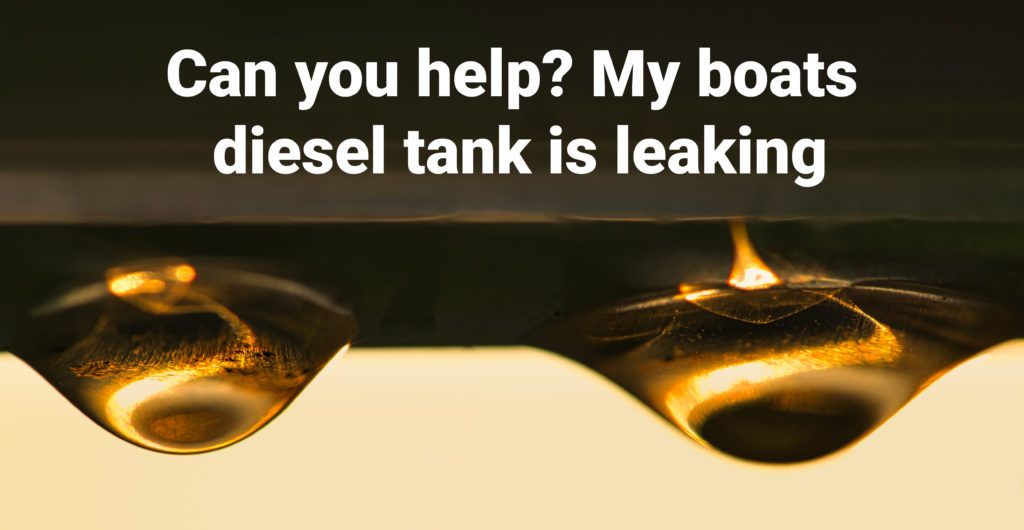As a leading manufacture and supplier of plastic tanks, this is a request we get quite often. Providing some idea as to how to deal with a problem such as this we have put together the following information.
Where’s the leak coming from and why?
It’s important to identify exactly where the leak is coming from and why it has happened. Sometimes it can be difficult to find the source, fuel can travel across the face of a tank before dripping off a fitting or low point some distance away. Don’t be tempted to just grab a spanner and tighten up all the tank fittings.
If the leak is coming from a fitting, it could be a simple matter of tightening up the hose clip, replacing a seal or renewing some thread compound or PTFE tape. If the fuel is coming from a weld then that’s a different matter altogether.
 If it’s a major leak then you need to try and capture the fuel the best you can. You may have no choice but to hold it in the bilge until you can pump it out into suitable containers. You may want to employ the services of a fuel polishing tank cleaning company or a boatyard to assist in the cleanup. If the leak is just a drip or two, then place a can to collect the fuel and organise a way of transferring and temporarily storing your fuel.
If it’s a major leak then you need to try and capture the fuel the best you can. You may have no choice but to hold it in the bilge until you can pump it out into suitable containers. You may want to employ the services of a fuel polishing tank cleaning company or a boatyard to assist in the cleanup. If the leak is just a drip or two, then place a can to collect the fuel and organise a way of transferring and temporarily storing your fuel.
Why has the weld failed?
It’s good to know why a weld has failed. if the reason is preventable, measures can be put in place to stop it happening again.
If a tank’s vent is blocked or restricted, filling the tank could over pressurise the tank and this could cause a weld to part.
If the tank is old, it could just be down to the age of the tank. Maybe you have been out in heavy seas and the vibration and wave action has popped an old weld. Plastic tanks are generally more forgiving than metal tanks and will absorb vibration, flex and move with a boat.
You can try to repair the tank but in our experience, unless you have good access, an onboard repair rarely works. The tank has to be drained, dried out, and cleaned. We have seen many tanks where attempts have been made to stop a weld from leaking: glass fibre patches, putty, plastic padding, glues and sealants, none of these work.
Your best bet is to get your tank out and have it thoroughly inspected. A metal tank can look great on the outside but the inside can be a whole different story. Water ingress will cause allmetal tanks to corrode.
How does water get into my tank?
There are many ways in which water can get into your fuel tank. A worn filler cap ‘O’ ring could allow water into your tank. When checking this O ring, check that the sealant between the filler and the deck is sound too. If water gets in here it won’t get into your tank but it could run down the outside of the filler pipe and pool on the top of your tank. This could easily go unnoticed and over time could cause a major corrosion issue on aluminium or mild steel tank.
The tank vent may have been incorrectly fitted and in stormy weather, water may be getting in this way. All diesel fuel contains some moisture and the ethanol and biofuel mixes don’t help to limit condensation forming in metal tanks.
Water has a higher density than diesel; once in your tank, the water will sink to the bottom. The layer between the diesel and water is where the microbes thrive, eventually reproducing in enough numbers to form biomass. Beneath the sludge, a variety of organic acids form and these attack the oxide pockets in the welds of a metal tank. Plastic tanks are not affected.
 Dependant on access, removing a tank can be expensive. A good way to inspect the inside condition of your tank in situ is to use an endoscope.
Dependant on access, removing a tank can be expensive. A good way to inspect the inside condition of your tank in situ is to use an endoscope.
Thanks to developments in technology, endoscope style cameras can now be used with a smartphone and they only cost just a few pounds, a very useful tool to have on board. Some display in 1080p and have the option to take a photo or video. This information can be emailed to a tank fabricator for analysis.
If your tank looks good on the inside then it’s probably worth having it repaired. A good marine metalwork fabricator will be able to cut out the weak weld and repair it for you.
We offer a plastic tank repair service: just email us a picture showing where the tank is leaking and one of our engineers will quickly be able to advise if it is repairable or not.
My tank is corroded on the inside: what are my options?
 If you have good access, then remove your tank and use it as a template for a new one. If
If you have good access, then remove your tank and use it as a template for a new one. If
you can’t deliver your existing tank to your fabricator, draw a sketch showing the dimensions and locations of the fittings.
Not all of us are artists or have access to the latest drawing software, we have produced a
tick box quotation sheet to help our customers.
Take a few pictures of your tank with your phone, the more information you can provide
the better.
One option would be to consider choosing a new location for your fuel tank, one that offers easy access. If you can fit a rectangular or cube-shaped plastic tank in, then one of our rotationally moulded plastic tanks would be an extremely cost-effective solution. Alternatively, we would be happy to quote for a custom tank. With no corrosion concerns, plastic tanks provide long term peace of mind.
Quite often tanks are buried in the depths of boats and to remove a tank can be a mammoth task. Bulkheads may need to be removed or the engine may need to come out to make way. If this is the case take some advise and consider cutting up your diesel tank and removing it from the boat piece by piece. The tank will need to be drained, cleaned and the area ventilated before work could begin. Be sure that this is the only option open to you before you proceed.
 It’s possible to replace your tank with a series of smaller balanced tanks. We have done this for many customers. The only downside to this approach is that you can lose a few litres of capacity.
It’s possible to replace your tank with a series of smaller balanced tanks. We have done this for many customers. The only downside to this approach is that you can lose a few litres of capacity.
If the solution is to have a new tank, take the opportunity to consider your pipework. You choose the location of the tank fitting best matching your installation.
If you have headroom have at least one inspection hatch on your new tank.
Good Practice
 It’s good practice to regularly check your fuel hoses and fittings, feel around the welds of your tank, check that your tank is dry overall especially on an aluminium tank. Keep the protective paintwork in good condition on a steel tank.
It’s good practice to regularly check your fuel hoses and fittings, feel around the welds of your tank, check that your tank is dry overall especially on an aluminium tank. Keep the protective paintwork in good condition on a steel tank.
Use an endoscope and see what’s going on inside your tank.
Draw off any sludge or particles from the bottom of your tank: a drill pump should be able to handle this job. Alternatively, a mobile diesel polisher will be able to do this for you.
The base of a tank should be supported through its entirety. Cushioning a tank is a good
idea, choose a material that doesn’t retain water such as rubber or neoprene. A constantly wet surface against the walls or on the bottom of a metal tank is not good.
 Pick where you purchase your fuel: what can happen in your tank can also happen in a marina’s tank.
Pick where you purchase your fuel: what can happen in your tank can also happen in a marina’s tank.
Keep your tank topped up especially if the boat is going to stand for some time: the less air in a metal tank the less condensation. Treat your fuel with a marine-grade biocide to prevent the growth of microbes.



